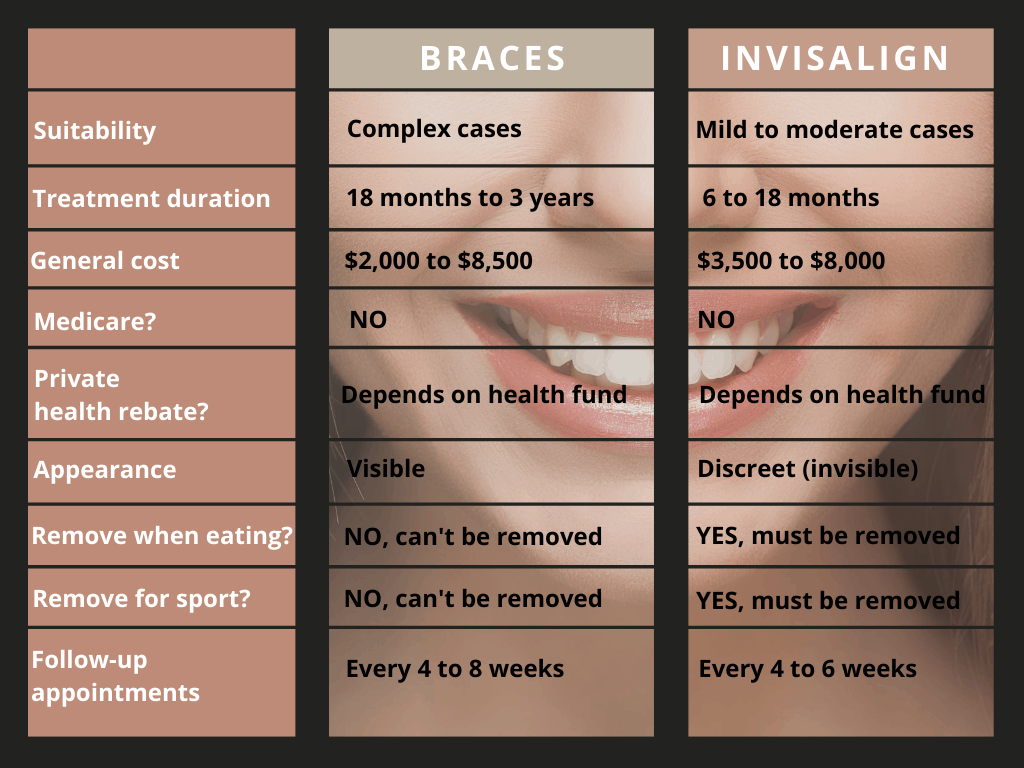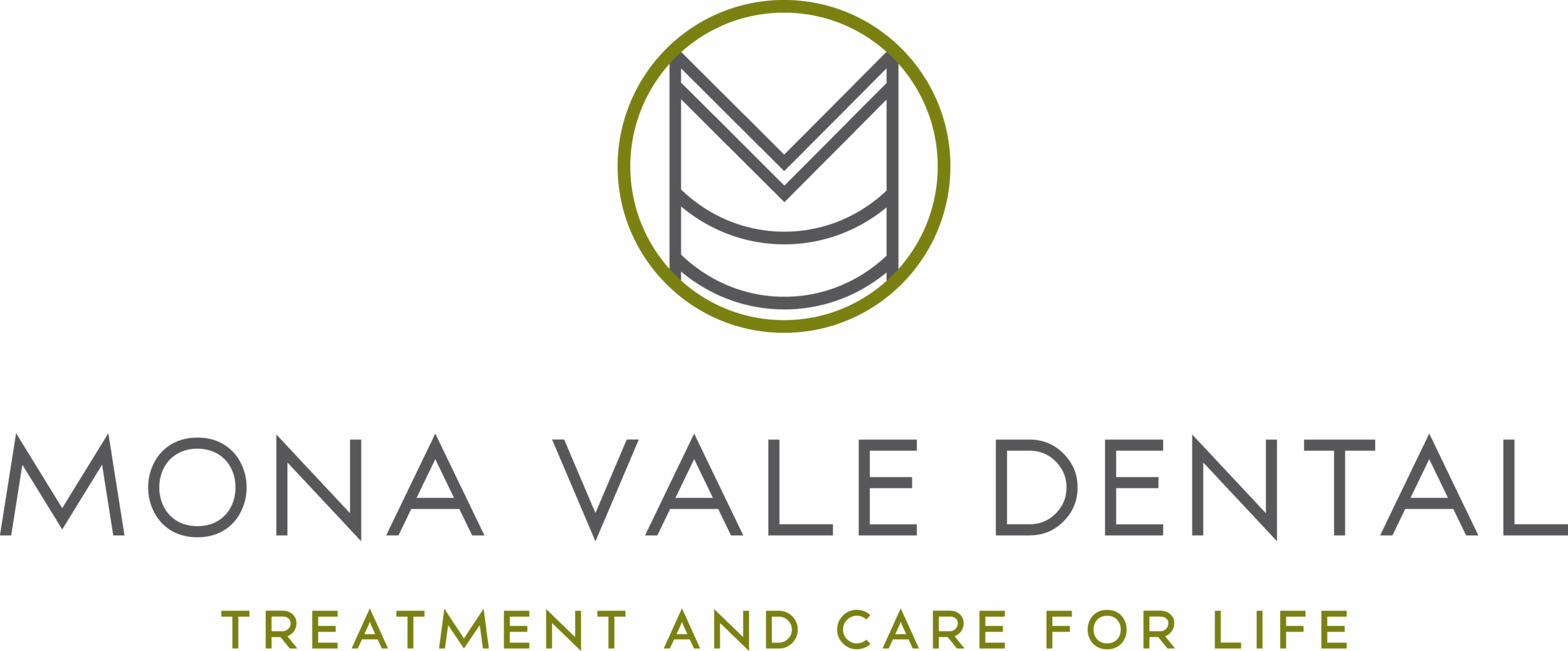Back in the day (before 1998), there was only one way to correct misalignment: dental braces.
However, Invisalign has now joined the ranks as a viable treatment to straighten teeth.
There are many factors to consider when choosing between braces and Invisalign.
Do I need orthodontic treatment in the first place?
Orthodontic treatment corrects the alignment of a patient’s teeth and jaw. It’s suitable for adults and children, but early intervention often works best to stop the problem from worsening over time.
Misalignment problems include:
- Crooked, crowded or protruding teeth
- Impacted teeth
- Overbite
- Underbite
- Crossbite
- Wide spaces between teeth
Some of the complications that occur when misalignment problems aren’t addressed:
- Lack of confidence around smiling
- Pain or tooth loss due to impaction
- Higher susceptibility to tooth decay and gum disease (as it’s harder to clean teeth properly)
Braces and Invisalign are two similar treatment options…
Dr Alistair Graham recommends braces for:
- People with mild to complex orthodontic issues
- People who are not confident that they will reliably wear aligners (in particular children or teenagers)
Dr Alistair Graham recommends Invisalign treatment for:
- People with mild to moderate orthodontic problems
- People who prefer a discreet option that’s difficult for others to see
- People who play contact sports, as the aligners can be removed
What are braces and who is this treatment suitable for?
Dental braces are metal or ceramic-based appliances that orthodontists or dentists fix to the teeth. Constant pressure is applied by the system of brackets and wires to gradually move the teeth into their set position.
This is a suitable option for patients with complex orthodontic issues, such as deep overbites. For patients with large overbites, braces can usually achieve alignment of the teeth faster than Invisalign.
What is Invisalign and who is this treatment suitable for?
Removable clear aligners move teeth into place by applying constant pressure. Every two weeks, the patient replaces their set of BPA-free plastic trays with a tighter version that shifts their teeth even more.
Invisalign is suitable for mild or moderate orthodontic problems. For example, crooked teeth, rotated teeth, gaps in teeth or overcrowding.
How long does each treatment take?
Average treatment time for braces: Braces are worn for around 12 months to 24 months (depending on how complicated the condition is). They’re worn 24/7 and cannot be removed during the treatment period.
Average treatment time for Invisalign: Most people need to wear their invisible aligners for 6 to 12 months. Aligners must be worn for at least 20 to 22 hours a day (they can be removed for eating).
The cost of orthodontics: how much are braces vs Invisalign?
Cost of braces:
In Australia, braces generally cost between $5,000 and $8,000 – depending on what type you get.
Traditional metal braces usually fall on the lower end of the scale, whereas ceramic braces can be more expensive as they’re less conspicuous (the patient can choose clear or tooth-coloured brackets that don’t stand out).
Cost of Invisalign:
You can expect to pay between $5,500 and $8,500 for Invisalign, which is usually a little pricier than ceramic or metal braces.
Factors that influence the cost of orthodontics
Payment plans:
Payment plans are often used to spread out the overall cost of the treatment.
Insurance:
Please note that orthodontic treatment isn’t covered by Medicare, however some of the cost may be covered under extras if you have private health insurance (depending on your policy). Ask your dentist or orthodontist for the health insurance item number, so you can check with your provider.
What is more discreet, Invisalign or dental braces?
Invisalign, without a doubt!
This is the main advantage over traditional braces, which are definitely more visible.
On the other hand, many patients with braces like to add a splash of colour to their brackets via their choice of elastics, which can be changed at each appointment to make a fashion statement. Children and teenagers particularly enjoy this!
What is easier to manage on a day-to-day basis (Invisalign vs braces)?
It depends on your lifestyle and preferences.
Many people find braces are easier to manage, because they don’t need to be removed when eating or drinking. This is a better option for patients who are less inclined to stick to the routine of removing and reinstalling the Invisalign aligners after each meal.
If you know that you won’t commit to this process, then it’s best to choose braces.
Daily maintenance of braces vs Invisalign aligners
Braces:
Brush brackets thoroughly while cleaning your teeth at least twice daily. Floss around the wires daily. You may require a special interdental brush to get into the spaces that are difficult to reach due to the wires.
Invisalign:
Rinse the aligners with lukewarm water every time you remove them from your mouth, to prevent the build-up of bacteria.
Twice a day (morning and night), gently brush the trays with a soft-bristled brush and toothpaste, before rinsing with lukewarm water.
Do not put hot water on your aligners, as this could damage the plastic trays.
Clean your own teeth after every meal, to avoid staining or trapped particles (make sure the aligners aren’t in your mouth when cleaning your own teeth).
What is more comfortable to wear, Invisalign or braces?
Invisalign is probably more comfortable because the plastic trays don’t contain metal.
Some patients with braces may experience discomfort during the first week, as a result of the brackets rubbing against their cheeks. However, this can be managed by covering the brackets with dental wax.
It’s also common for braces wearers to experience a small amount of tenderness after getting their braces adjusted (tightened) at follow-up appointments. We recommend eating soft foods during this time.
How often do I need to have follow-up appointments?
Braces: Follow-up appointments are generally every four to eight weeks, however there’s no strict rule for this (it depends on the individual case). The orthodontist or dentist checks how the patient is progressing, tightens the braces and replaces the wires if necessary.
Invisalign: Follow-up appointments occur every four to eight weeks. The orthodontist or dentist monitors progress and gives the patient a series of aligners that will last until their next appointment (note: the patient changes their aligners to a tighter version every one to two weeks, depending on the instructions they’ve been given).
Is there anything that I can’t consume with Invisalign vs braces?
Braces: Avoid brittle, chewy or sticky foods that might damage your braces (everything else is fine).
Invisalign: Avoid food while the plastic trays are in your mouth. Aligners should be removed when eating or drinking anything other than water.
What option is best for you? Book a complimentary consultation…
We can discuss the best option for you during a complimentary consultation – contact us on (02) 9997 1100 to book an appointment.
If you’d like to read more information about orthodontic treatment, please refer to this FAQ on Invisalign and braces.








